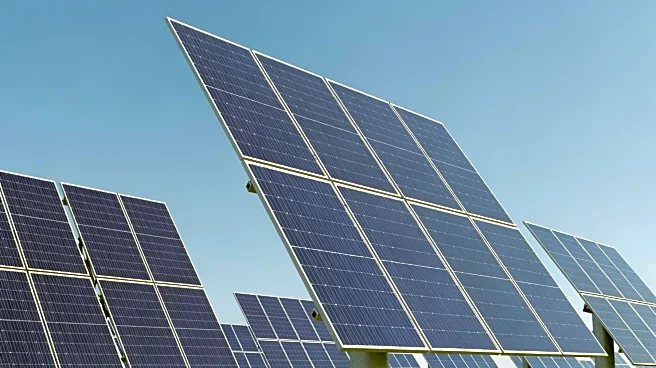What's Happening?
The European Investment Bank (EIB) has signed a €500 million green loan agreement with Iberdrola, supported by the Spanish export credit agency, Cesce. This funding is directed towards the construction of the Windanker offshore wind farm in the German
Baltic Sea, which will have a capacity of 315 MW upon completion. The project is expected to generate renewable electricity for approximately 600,000 people annually. The wind farm will utilize 21 Siemens Gamesa SG 14-236 DD turbines, each capable of producing up to 15 MW. Turbine installation is scheduled to begin in 2026, with full commissioning anticipated by the end of the same year. The construction phase is projected to create about 2,200 person-years of employment, while ongoing operations will require up to 160 skilled permanent jobs. The wind farm aims to reduce carbon emissions by an estimated 672,000 tons of CO2 annually, contributing to Germany's goal of achieving an 80% renewable share in electricity by 2030.
Why It's Important?
The development of the Windanker offshore wind farm represents a significant step towards reducing reliance on fossil fuels and enhancing renewable energy capacity in Germany and Europe. By generating green electricity, the project supports Europe's efforts to achieve energy independence and reduce carbon emissions. The investment in offshore wind power aligns with Germany's renewable energy targets and contributes to the broader European goal of transitioning to sustainable energy sources. The project also highlights the economic benefits of renewable energy development, including job creation and technological advancement. As Europe faces challenges related to fossil fuel imports and energy price volatility, projects like Windanker offer a sustainable alternative that can stabilize energy costs and promote environmental sustainability.
What's Next?
The Windanker offshore wind farm is set to begin turbine installation in 2026, with full commissioning expected by the end of the same year. As the project progresses, stakeholders will likely monitor its impact on local economies and energy markets. The successful implementation of this project could encourage further investments in offshore wind energy across Europe, particularly in regions with high wind power potential like the Baltic Sea. Additionally, the project's contribution to reducing carbon emissions may influence policy decisions and inspire similar initiatives aimed at achieving renewable energy targets. The collaboration between EIB, Iberdrola, and Cesce may serve as a model for future green financing efforts, promoting sustainable energy development on a larger scale.
Beyond the Headlines
The Windanker project underscores the growing importance of offshore wind energy in Europe's renewable energy landscape. While onshore wind power remains a central component of Germany's electricity generation, offshore projects like Windanker offer unique advantages, including higher capacity and reduced visual impact. The project's location in the Baltic Sea, with its substantial wind power potential, highlights the strategic importance of regional collaboration in harnessing renewable energy resources. As countries like Poland, Sweden, and Estonia explore offshore wind opportunities, the Windanker project may serve as a catalyst for cross-border cooperation and innovation in renewable energy technologies. Furthermore, the project's focus on reducing carbon emissions aligns with global efforts to combat climate change and transition to sustainable energy systems.














